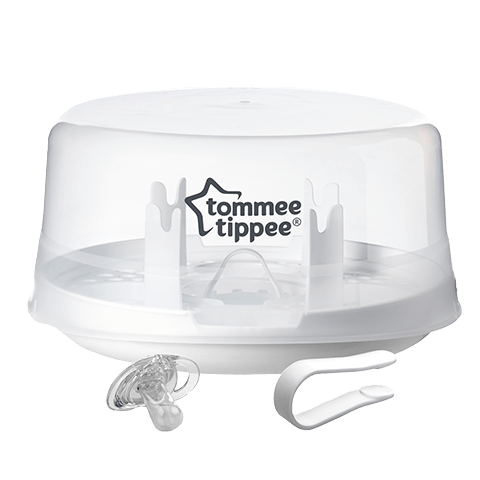Tommee Tippee Easi-Warm Bottle & Food Warmer

Easi-Warm Bottle & Food Warmer
Getting Started
Do you have a question about using your Tommee Tippee Bottle and Food Warmer? Find the answers here.
Using your Bottle and Food Warmer
The speed at which your bottle and food warmer heats milk or food will depend on the size of the bottle or container and the starting temperature of the milk or food (e.g. room temperature 68˚F or from the refrigerator 41˚F).
We recommend that you always use setting 3 for heating up, and use setting 2 for keeping warm only. Setting 1 is a minimum setting and should not be used for warming.
DO NOT warm milk or food in your warmer for more than 30 minutes.
To warm bottles
1. Place your filled bottle in the bottle and food warmer.
2. Fill the bottle and food warmer with water to the inside fill line using a jug or bottle (unless using a 150ml bottle). For a smaller bottle fill to the underside of the screw ring. Never let the water overflow or rise above the neck of the bottle.
3. Before plugging in, make sure your bottle and food warmer is switched to setting 1. Ensure your hands are dry.
4. Plug in your bottle and food warmer.
5. Turn dial to setting 2. The amber light will turn on to indicate the bottle and food warmer is switched on and is heating up.
6. As the water heats up, the amber light will switch off and on to prevent the water overheating. The light going out does not indicate that the milk is ready. Please refer to the timings table to find out how long you should heat milk for.
7. Heat the milk to the desired temperature, following the heating guidelines to ensure that the milk is not heated for too long.
8. Take care when removing the bottle, as it and the surrounding water will be hot.
9. For your child’s safety always check the milk temperature before feeding by testing on a sensitive part of your skin. Take care not to overheat the milk. Gently agitate the bottle before feeding.
10. During feeds you can place a bottle back in the warmer to keep milk warm by using setting 2. The thermostat will maintain the temperature of the water. The indicator light will only switch to amber to indicate the warmer is heating up when the water has sufficiently cooled.
11. At the end of each feed, turn back the dial to setting 1 and unplug the unit after feeding.
12. Empty the unit of any water and wipe dry.
To warm baby food jars
1. Remove the lid and place the jar in the bottle and food warmer.
2. Fill the bottle and food warmer with water to the inside edge using a jug or bottle. Ensure the water level is lower than the rim of the jar.
3. Before plugging in, make sure the bottle and food warmer is switched to setting 1.
4. Plug IN your bottle and food warmer.
5. Turn dial to setting 3 to heat up food. The amber light will turn on to indicate the bottle and food warmer is switched on and is heating up.
6. As the water is heats up, the amber light will switch off and on to prevent the water overheating. The light going out does not indicate that the food is ready.
7. Heat food to the desired temperature. Follow the heating guidelines to ensure that the food is not heated for too long.
8. Take care when removing the jar, as the surrounding water will be hot.
9. For your child’s safety always check food temperature before feeding by testing on a sensitive part of your skin. Take care not to overheat the food.
10. During feeding you can place the jar back in the warmer to keep the food warm by using setting 2. The thermostat will maintain the temperature of the water. The indicator light will only switch to amber to indicate the warmer is heating up when the water has sufficiently cooled.
11. Turn back the dial to setting 1 and unplug your food and bottle warmer after feeding.
12. Empty the unit of water and wipe dry.
Heating guidelines

Cleaning & Maintenance
To clean your baby food and bottle warmer
Unplug your food and bottle warmer and allow to cool before cleaning. After each use pour away any remaining water from the base by the tipping it sideways over a sink.
Wipe clean with a damp cloth only. Do not clean with abrasive cleaners or allow to come into contact with solvents or harsh chemicals, as this could cause damage.
To descale your baby food and bottle warmer
A build-up of limescale can negatively affect the performance of your warmer. To keep it working effectively we recommend carrying out the descaling process using these frequency guidelines:
Hard water – 7 days
Medium – 14 days
Soft – 21 days
You can find out your water quality via your water provider.
1. Use a descaler that is suitable for use with stainless steel i.e. kettle, iron and coffee machine de-scaler. Use as per the manufacturer’s guidelines.
2. Alternatively, you can use white vinegar to descale your food and bottle warmer.
DO NOT use metal objects or scourers to clean your food and bottle warmer. DO NOT use bleach to clean the food and bottle warmer. DO NOT use abrasive or anti-bacterial materials.
How do I descale?
Descaling is really easy to do, simply allow your warmer to cool and unplug before descaling. We recommend using a descaler that is suitable for use with stainless steel i.e. kettle, iron and coffee machine de-scaler. And following the manufacturer’s instructions. However, you can use white vinegar if you prefer.
Why should I descale?
The descaling process removes deposits of calcium and other minerals within the system that may affect its performance or shorten the life of the warmer.
How often should I descale?
This really does depend on the area in which you live. If the water in your area is hard then you may need to descale every 7 days. If it’s medium, then you’ll need to descale every 14 days and if the water is soft it’s around every 21 days. You can find out the quality of your water from your water provider. How quickly scale builds up in your kettle is also a good clue to how frequently you will need to descale.
Can I use pouches in this warmer?
No, this warmer is purely for bottles or jars of food. However, we do have our Advanced Bottle and Pouch Warmer for pouches.
How long will it take for a bottle/jar to warm?
This all depends on the size of the bottle or jar and the temperature of the contents. It also depends on the temperature of the water you add to the warmer.
Here’s our guide to times:
Can I use glass or silicone bottles with this warmer?
Yes.







